A Simulation and Experiment on the Optimization Design of an Air Outlet Structure for an Air-Assisted Sprayer
Abstract
:1. Introduction
2. Materials and Methods
2.1. Machine Structure and Air-Assisted Principle
2.2. Determination of Parameters for Axial-Flow Fans
2.2.1. Calculation of Fan Air Volume
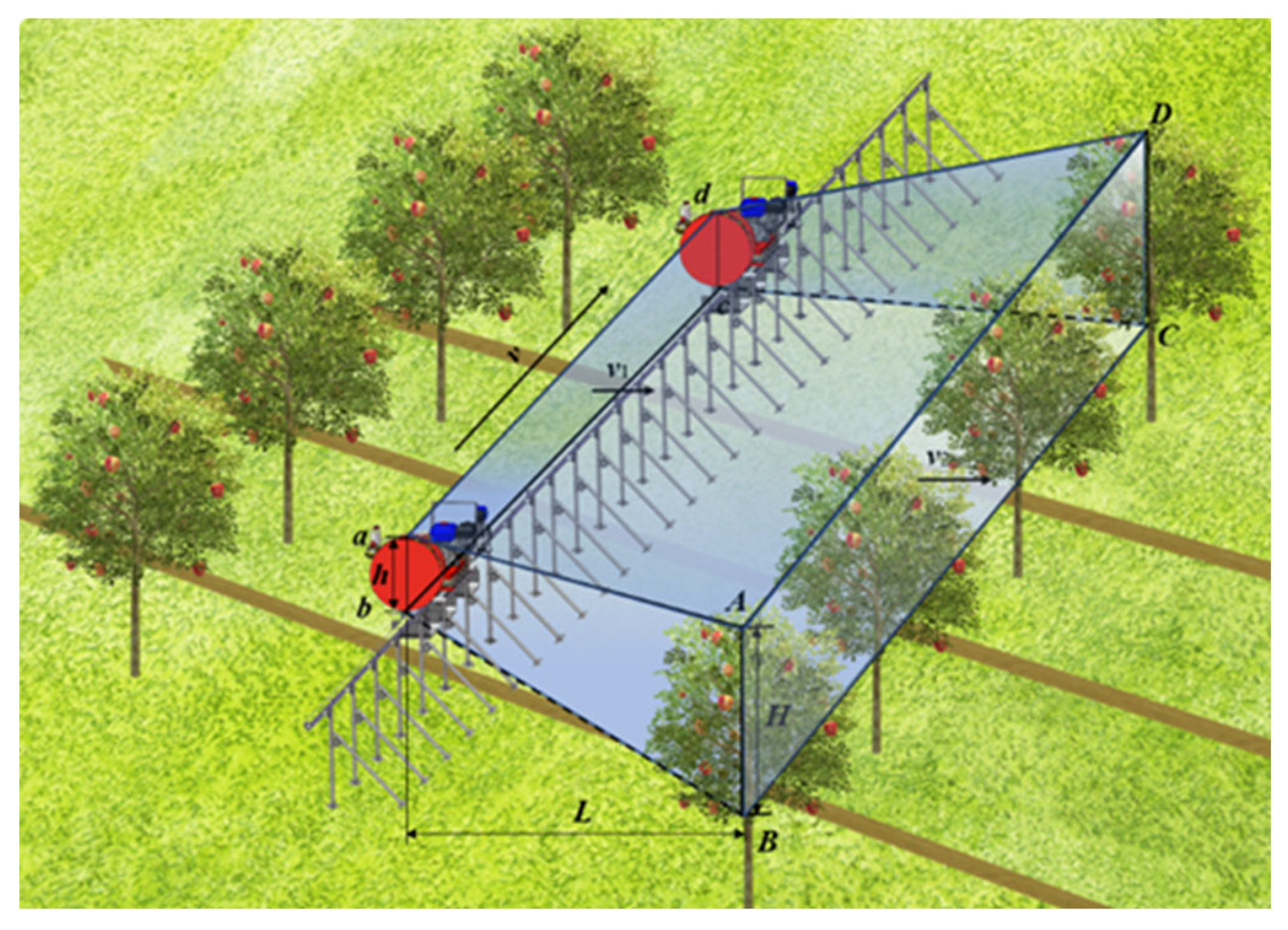
2.2.2. Calculation of Wind Speed at the Outlet of the Fan
2.3. Structure Design of Arc-Shaped Air Outlet
2.4. Field Experimental Method
2.4.1. Measurement of the Outflow at the Air Outlet and the External Airflow Field
2.4.2. Experiment of Fog Droplet Collection in the Fog Collection Chamber
3. Results and Discussion
3.1. Analysis of Results before and after Optimization
3.2. Analysis of the Parameters of the Arc-Shaped Air Outlet’s Rounded Corner Radius
3.3. Field Experimental Results and Analysis
3.3.1. Test Verification of Air Outlet
| Fillet Radius/mm | Simulation Result/(m·s−1) | Measured Results /(m·s−1) | Error/% |
|---|---|---|---|
| 0 | 14.95 | 13.65 | 9.52 |
| 10 | 16.11 | 15.79 | 2.03 |
| 20 | 17.31 | 16.62 | 4.15 |
| 30 | 17.75 | 16.85 | 5.34 |
| 40 | 17.91 | 17.56 | 1.99 |
| 50 | 18.02 | 17.69 | 1.87 |
| 60 | 18.17 | 17.56 | 3.47 |
| 70 | 18.2 | 17.76 | 2.48 |
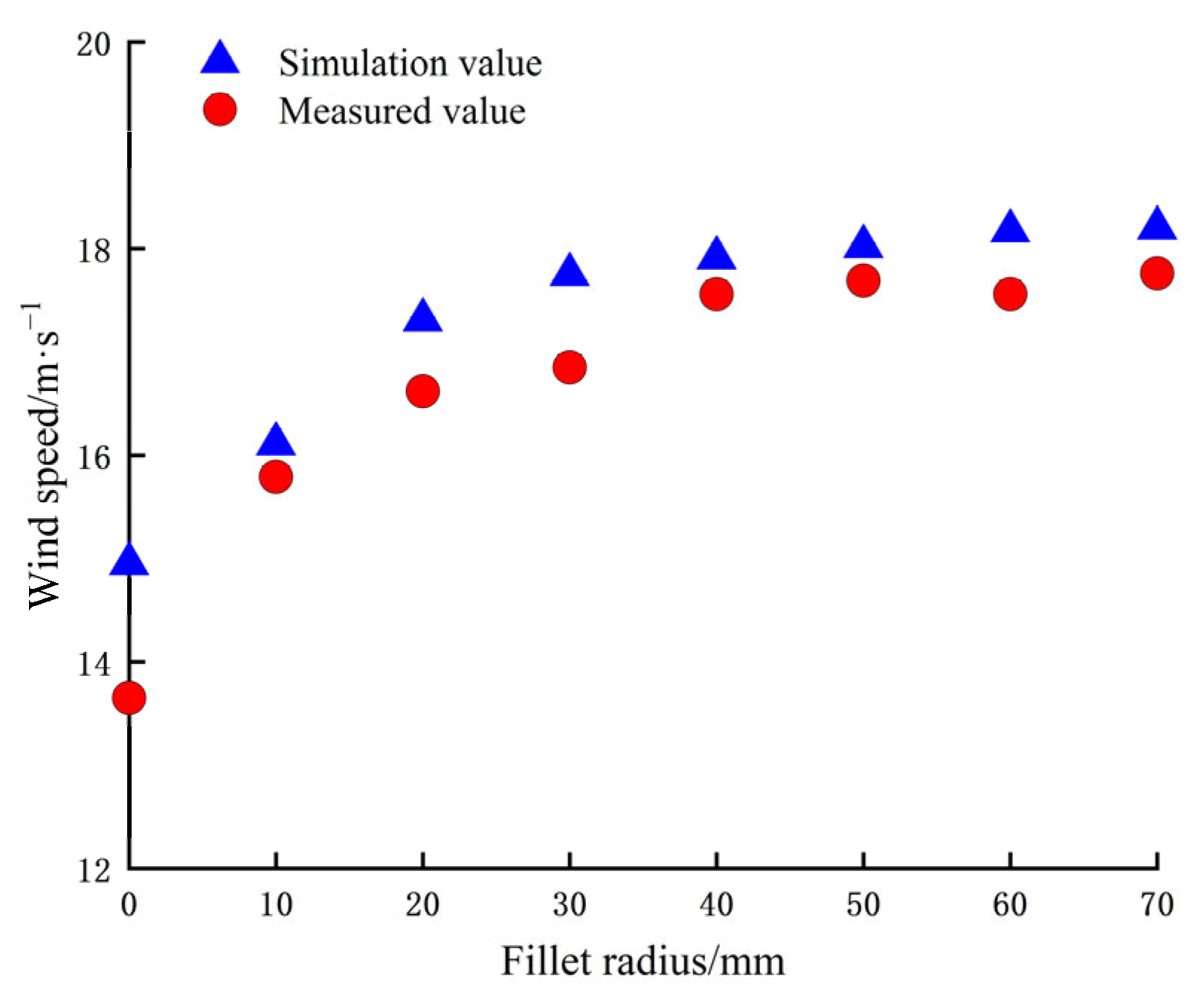
3.3.2. Analysis of the Characteristics of External Space Wind Flow Field
3.3.3. Analysis of Fog Droplet Collection in the Fog Collection Chamber
4. Conclusions
Author Contributions
Funding
Institutional Review Board Statement
Data Availability Statement
Acknowledgments
Conflicts of Interest
References
- An, Q.; Li, D.; Wu, Y.; Pan, C. Deposition and distribution of myclobutanil and tebuconazole in a semidwarf apple orchard by hand-held gun and air-assisted sprayer application. Pest Manag. Sci. 2020, 76, 4123–4130. [Google Scholar] [CrossRef] [PubMed]
- Zheng, Y.J.; Chen, B.T.; Lu, H.T.; Kang, F.; Jiang, S.J. Research progress of orchard plant protection mechanization technology and equipment in China. Trans. Chin. Soc. Agric. Eng. 2020, 36, 110–124. [Google Scholar]
- Zhai, C.; Zhao, C.; Wang, X.; Li, W.; Li, W.; Zhu, R. Nozzle test system for droplet deposition characteristics of orchard air-assisted sprayer and its application. Int. J. Agric. Biol. Eng. 2014, 7, 122–129. [Google Scholar]
- Qiu, W.; Zhao, S.; Ding, W.; Sun, C.; Lu, J.; Li, Y.; Gu, J. Effects of fan speed on spray deposition and drift for targeting air-assisted sprayer in pear orchard. Int. J. Agric. Bioeng. 2016, 9, 10. [Google Scholar]
- Bahlol, H.Y.; Chandel, A.K.; Hoheisel, G.A.; Khot, L.R. The smart spray analytical system: Developing understanding of output air-assist and spray patterns from orchard sprayers. Crop Prot. 2020, 127, 104977. [Google Scholar] [CrossRef]
- Salcedo, R.; Pons, P.; Llop, J.; Zaragoza, T.; Campos, J.; Ortega, P.; Gallart, M.; Gil, E. Dynamic evaluation of airflow stream generated by a reverse system of an axial fan sprayer using 3D-ultrasonic anemometers. Effect of canopy structure. Comput. Electron. Agric. 2019, 163, 104851. [Google Scholar] [CrossRef]
- Qiu, W.; Sun, H.; Sun, Y.H.; Liao, Y.Y.; Zhou, L.F.; Wen, Z.J. Design and test of circulating air-assisted sprayer for dwarfed orchard. Trans. Chin. Soc. Agric. Eng. 2021, 37, 18–25. [Google Scholar]
- He, X.K. Research and development of efficient plant protection equipment and precision spraying technology in China: A review. Acta Phytophylacica Sin. 2022, 49, 389–397. [Google Scholar]
- Li, J.; He, M.; Cui, H.; Lin, P.; Chen, Y.; Ling, G.; Huang, G.; Fu, H. Characterizing Droplet Retention in Fruit Tree Canopies for Air-Assisted Spraying. Agriculture 2022, 12, 1093. [Google Scholar] [CrossRef]
- Duga, A.; Ruysen, K.; Dekeyser, D.; Nuyttens, D.; Baylemans, D.; Nicolai, B.; Verboven, P. CFD Based Analysis of the Effect of Wind on Orchard Spraying. Chem. Eng. Trans. (CET J.) 2015, 44, 289–294. [Google Scholar]
- García-Ramos, F.J.; Malón, H.; Aguirre, A.J.; Boné, A.; Puyuelo, J.; Vidal, M. Validation of a CFD Model by Using 3D Sonic Anemometers to Analyse the Air Velocity Generated by an Air-Assisted Sprayer Equipped with Two Axial Fans. Sensors 2015, 15, 2399–2418. [Google Scholar] [CrossRef]
- Lee, I.B.; Bitog, J.P.P.; Hong, S.W.; Seo, I.H.; Kwon, K.S.; Bartzanas, T.; Kacira, M. The past, present and future of CFD for agro-environmental applications. Comput. Electron. Agric. 2013, 93, 168–183. [Google Scholar] [CrossRef]
- Hong, S.W.; Zhao, L.; Zhu, H. CFD simulation of pesticide spray from air-assisted sprayers in an apple orchard: Tree deposition and off-target losses. Atmos. Environ. 2018, 175, 109–119. [Google Scholar] [CrossRef]
- Hu, Y.; Chen, Y.; Wei, W.; Hu, Z.; Li, P. Optimization design of spray cooling fan based on CFD simulation and field experiment for horticultural crops. Agriculture 2021, 11, 566. [Google Scholar] [CrossRef]
- Cheng, H.H.; Chung, W.G. An optimal design for axial-flow fan blade: Theoretical and experimental studies. J. Mech. Sci. Technol. 2012, 26, 427–436. [Google Scholar]
- Qu, F.; Sheng, X.Y.; Li, X.; Zhang, J.X.; Li, W.; Liu, J.Y. Improved Design of 3WZF-400A Orchard Air-assisted Sprayer. Trans. Chin. Soc. Agric. Mach. 2017, 48, 15–21. [Google Scholar]
- Li, J.P.; Bing, Y.L.; Huo, P.; Wang, P.F.; Xue, C.L.; Yang, X. Design and Experimental Optimization of Spray Device for Air-fed Annular Nozzle of Sprayer. Trans. Chin. Soc. Agric. Mach. 2021, 52, 79–88. [Google Scholar]
- Ru, Y.; Chen, X.Y.; Liu, B.; Wang, S.J.; Lin, M. Optimized Design and Performance Test of Axial Flow Orchard Sprayer Air Delivery System. Trans. Chin. Soc. Agric. Mach. 2022, 53, 147–157. [Google Scholar]
- Song, S.; Xia, H.; Liu, H.; Hong, T.; Sun, D.; Lu, Y. Numerical Simulation and Experiment of Structural Optimization for Air-blast Sprayer. Trans. Chin. Soc. Agric. Mach. 2013, 44, 73–78+55. [Google Scholar]
- Salcedo, R.; Fonte, A.; Grella, M.; Garcerá, C.; Chueca, P. Blade pitch and air-outlet width effects on the airflow generated by an airblast sprayer with wireless remote-controlled axial fan. Comput. Electron. Agric. 2021, 190, 106428. [Google Scholar] [CrossRef]
- Fan, G.; Wang, S.; Bai, P.; Wang, D.; Shi, W.; Niu, C. Research on Droplets Deposition Characteristics of Anti-Drift Spray Device with Multi-Airflow Synergy Based on CFD Simulation. Appl. Sci. 2022, 12, 7082. [Google Scholar] [CrossRef]
- Hong, S.W.; Zhao, L.; Zhu, H. CFD simulation of airflow inside tree canopies discharged from air-assisted sprayers. Comput. Electron. Agric. 2018, 149, 121–132. [Google Scholar] [CrossRef]
- Ou, Y.M.; Liu, Q. Selection and Calculation of Axial Flow Fan on the Air-blast Sprayer. J. Chin. Agric. Mech. 2004, 2, 24–25. [Google Scholar]
- Zhang, X.H.; Jiang, Z.Y.; Fan, G.Q.; Cao, L.L. Self-propelled Crawler Directional Air-blowing Orchard Sprayer. Trans. Chin. Soc. Agric. Mach. 2014, 45, 117–122, 247. [Google Scholar]
- Dai, F.F. Selection and calculation of the blowing rate of air-assisted sprayers. Plant Prot. 2008, 34, 124–127. [Google Scholar]
- Zhai, C.Y.; Zhang, Y.N.; Dou, H.J.; Wang, X.; Chen, L.P. CFD Modeling and Experiment of Airflow at the Air Outlet of Orchard Air-Assisted Sprayer. Smart Agric. 2021, 3, 70–81. [Google Scholar]
- GB/T 24683-2009; Standard Test Method for Air-Assisted Sprayers for Trees and Bushes in Plant Protection Machinery. Standardization Administration of China: Beijing, China, 2009.
- GB/T20183.2-2006; Agricultural Machinery for Plant Protection—Spraying Equipment. Standardization Administration of China: Beijing, China, 2006.
- Li, J.P.; Li, S.B.; Yu, S.M. Deposition Characteristics of Umbrella Wind Field Type Anti-drift Spray Device. Trans. Chin. Soc. Agric. Mach. 2023, 54, 80–91. [Google Scholar]
- Hu, J.; Liu, C.X.; Chu, X. Droplet Deposition Characteristics of Conical Wind Field Anti-drift Device. Trans. Chin. Soc. Agric. Mach. 2020, 51, 142–149, 174. [Google Scholar]
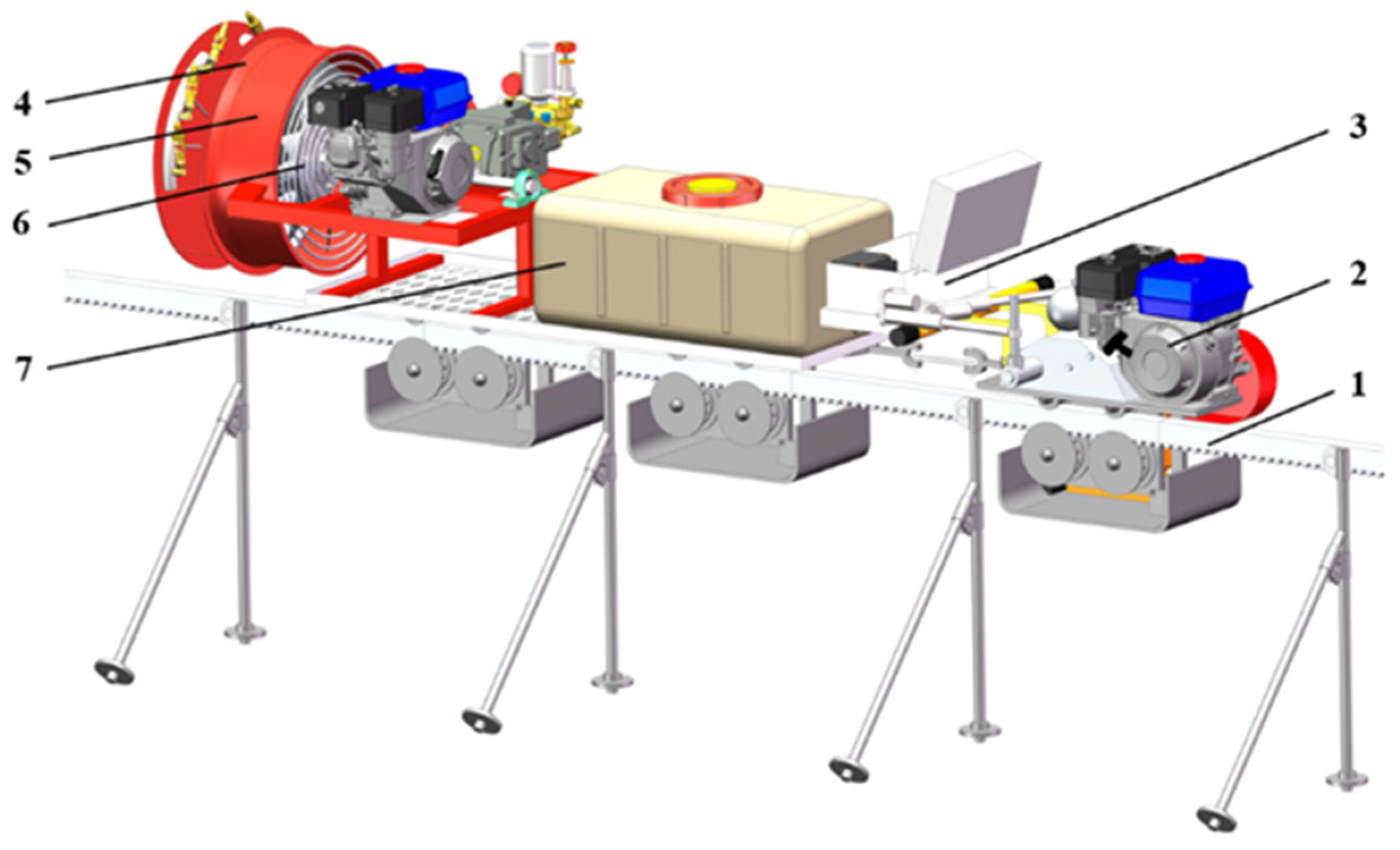
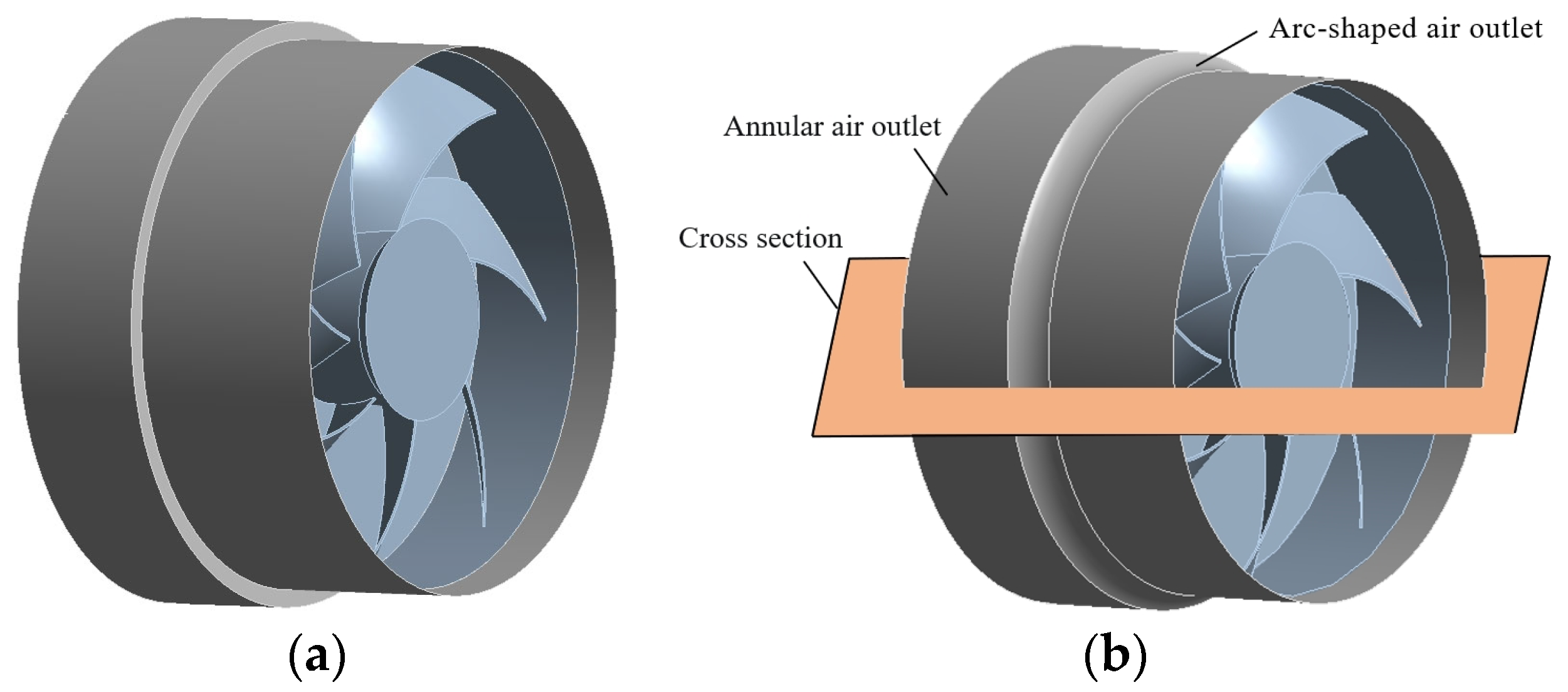
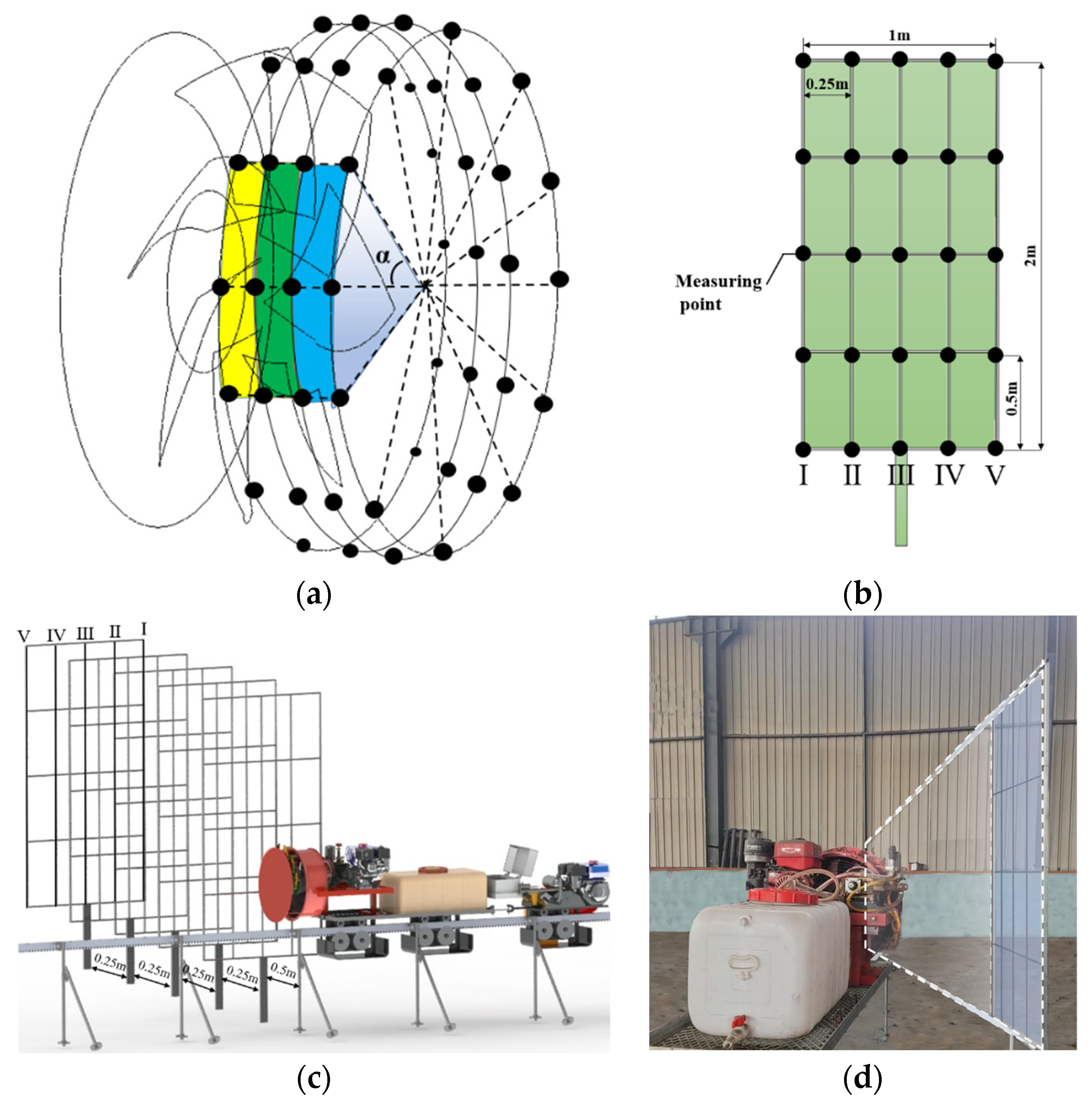
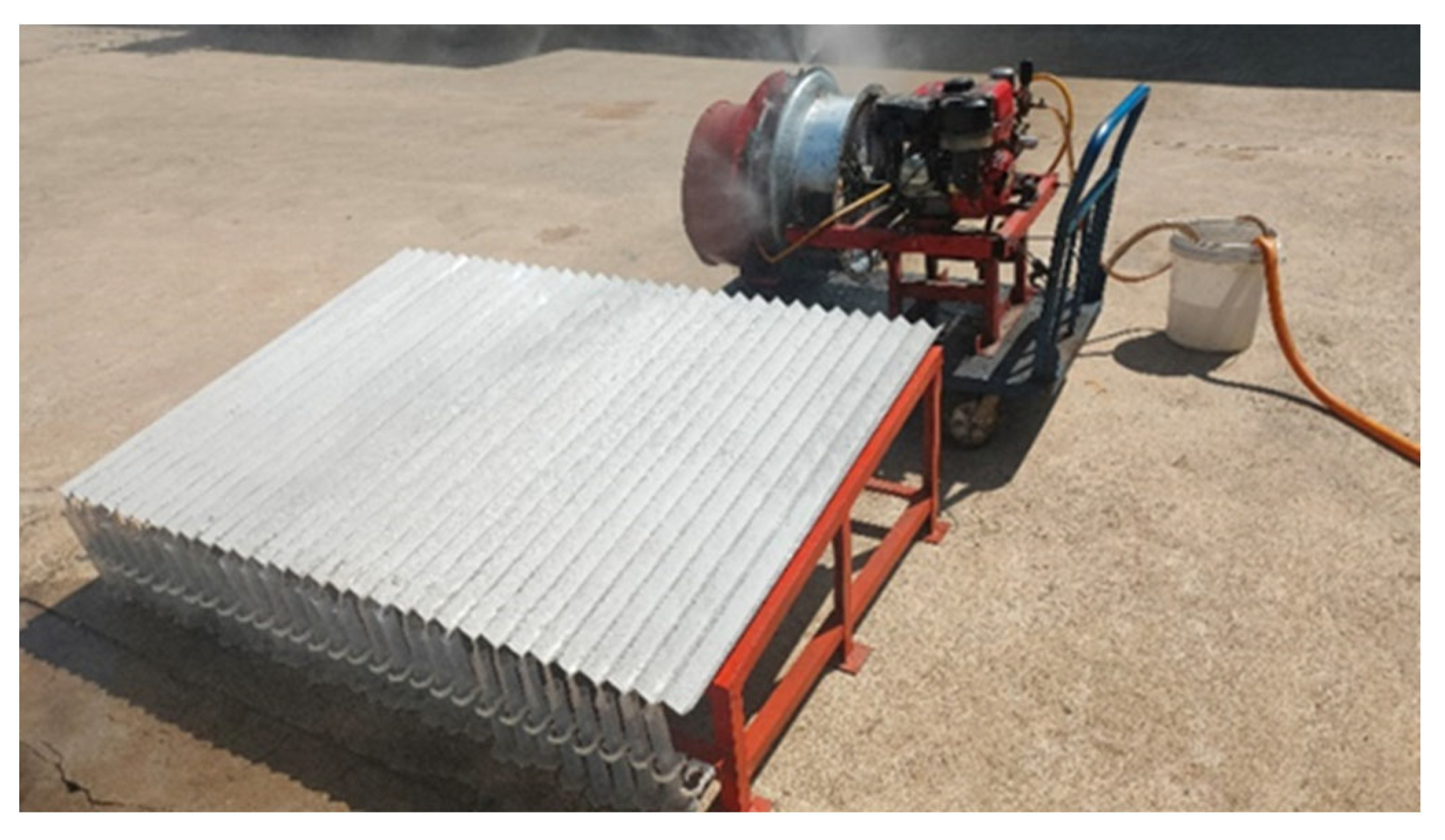
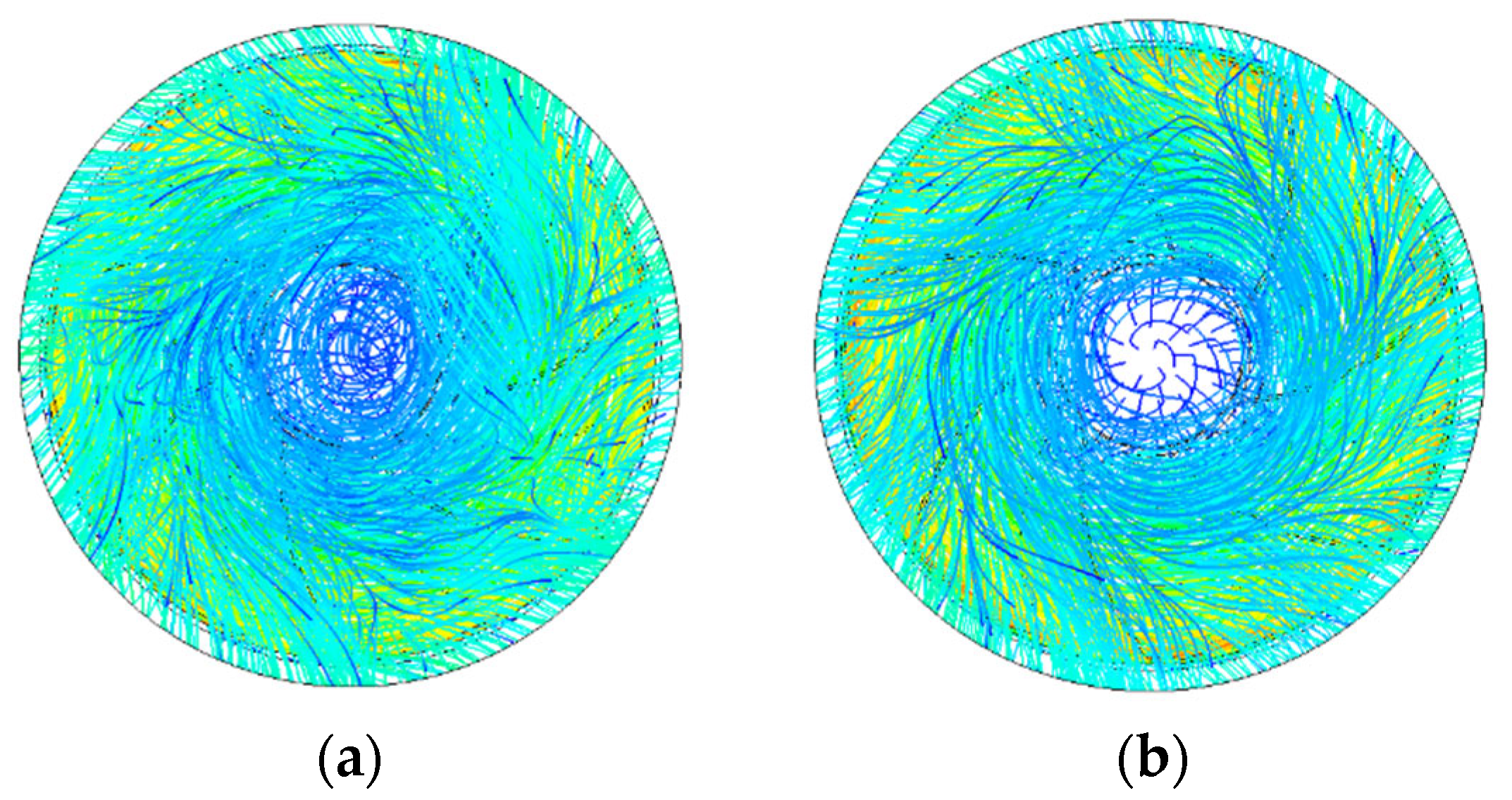
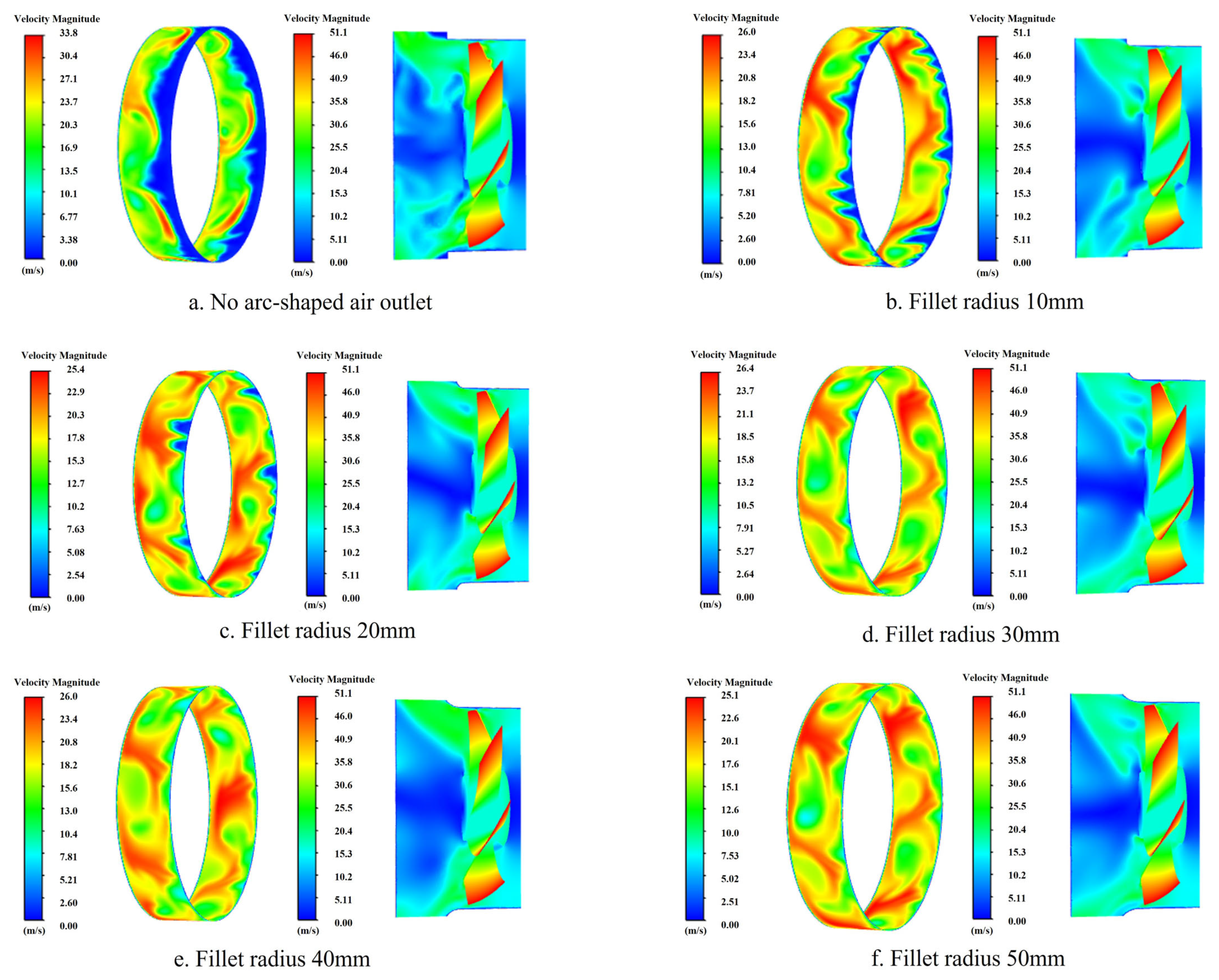

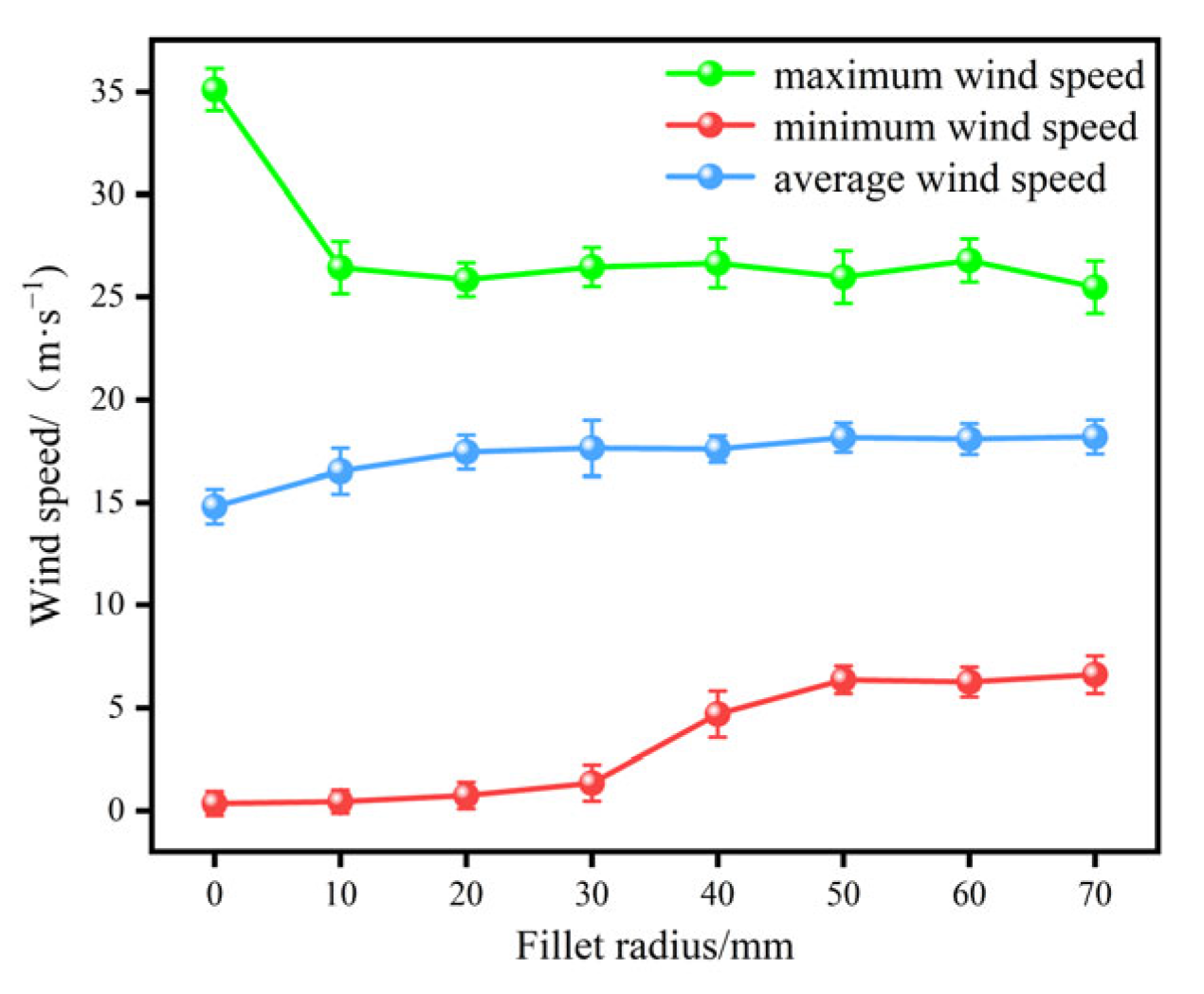
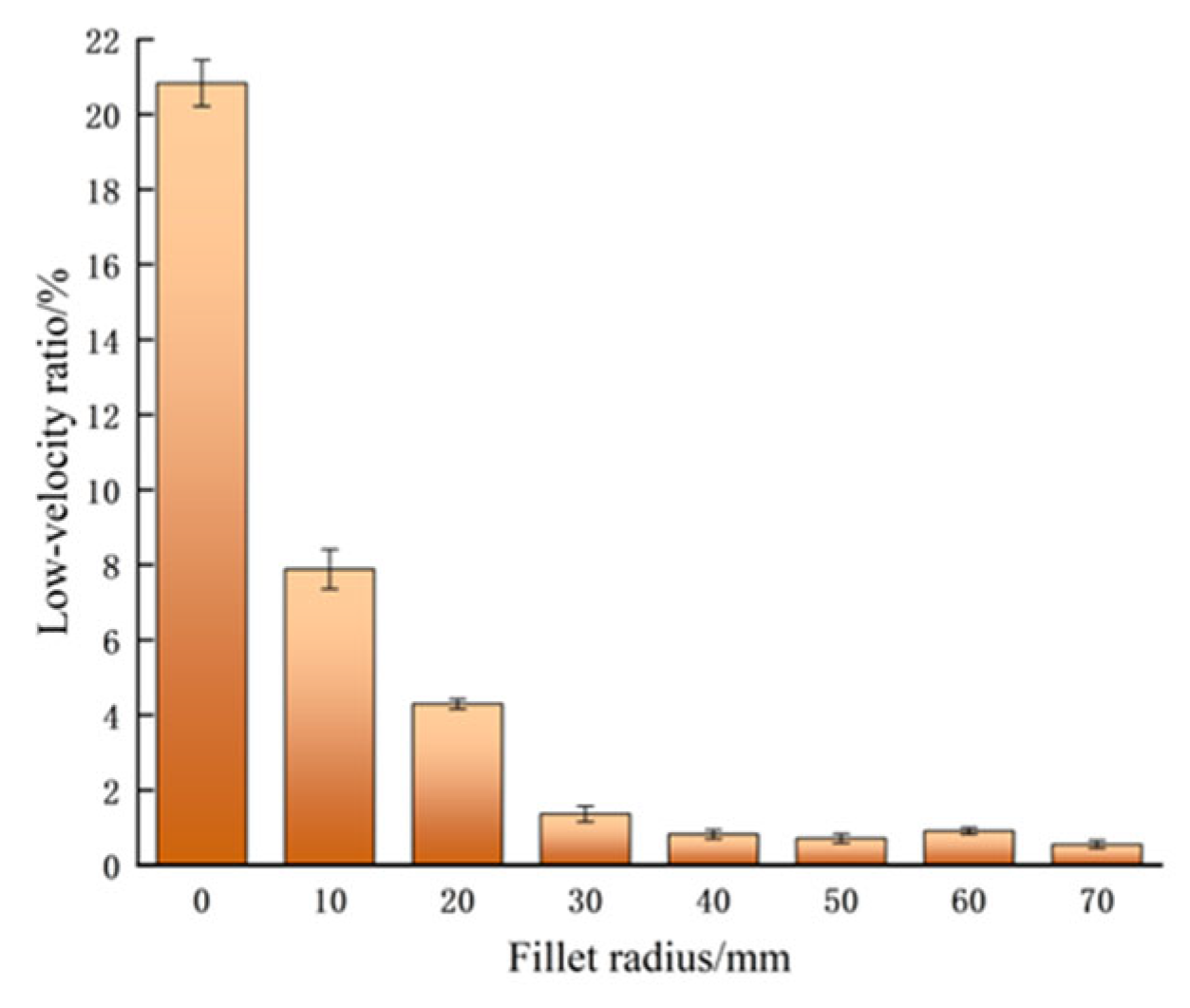
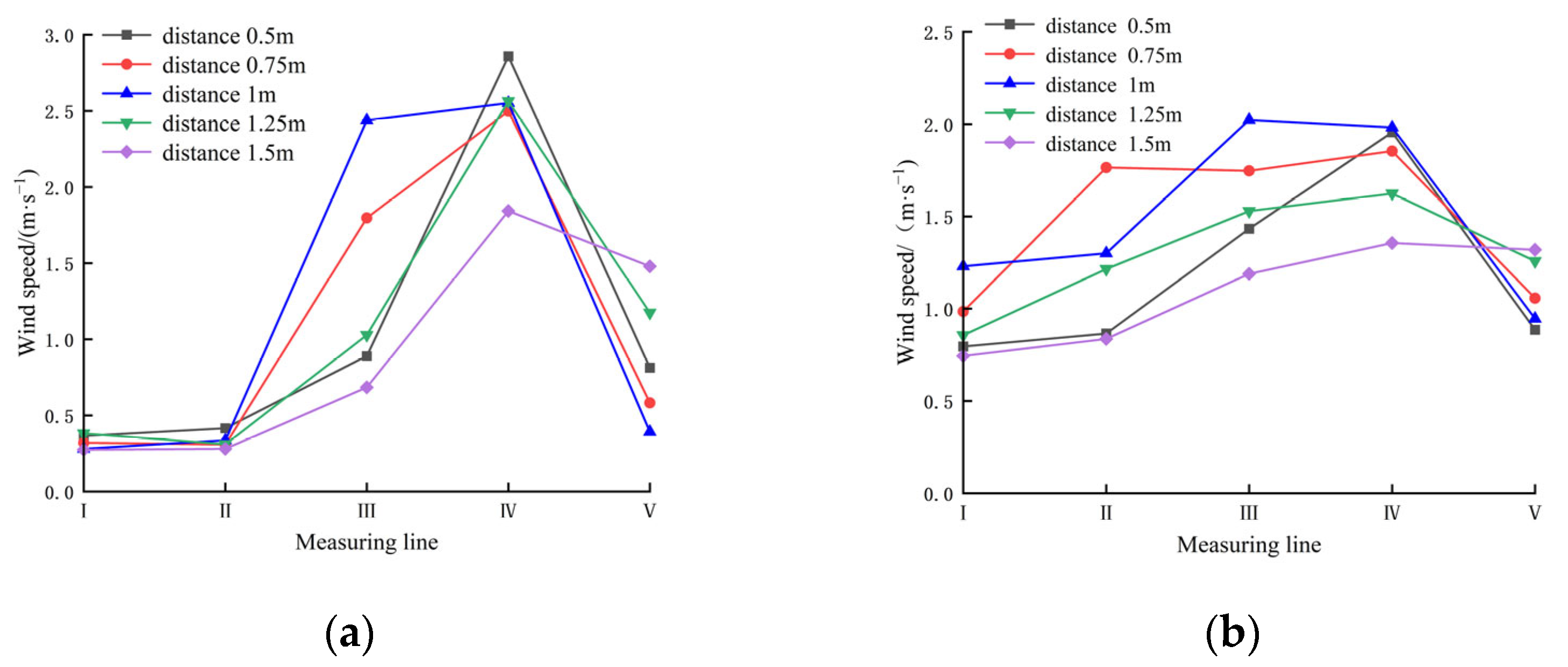
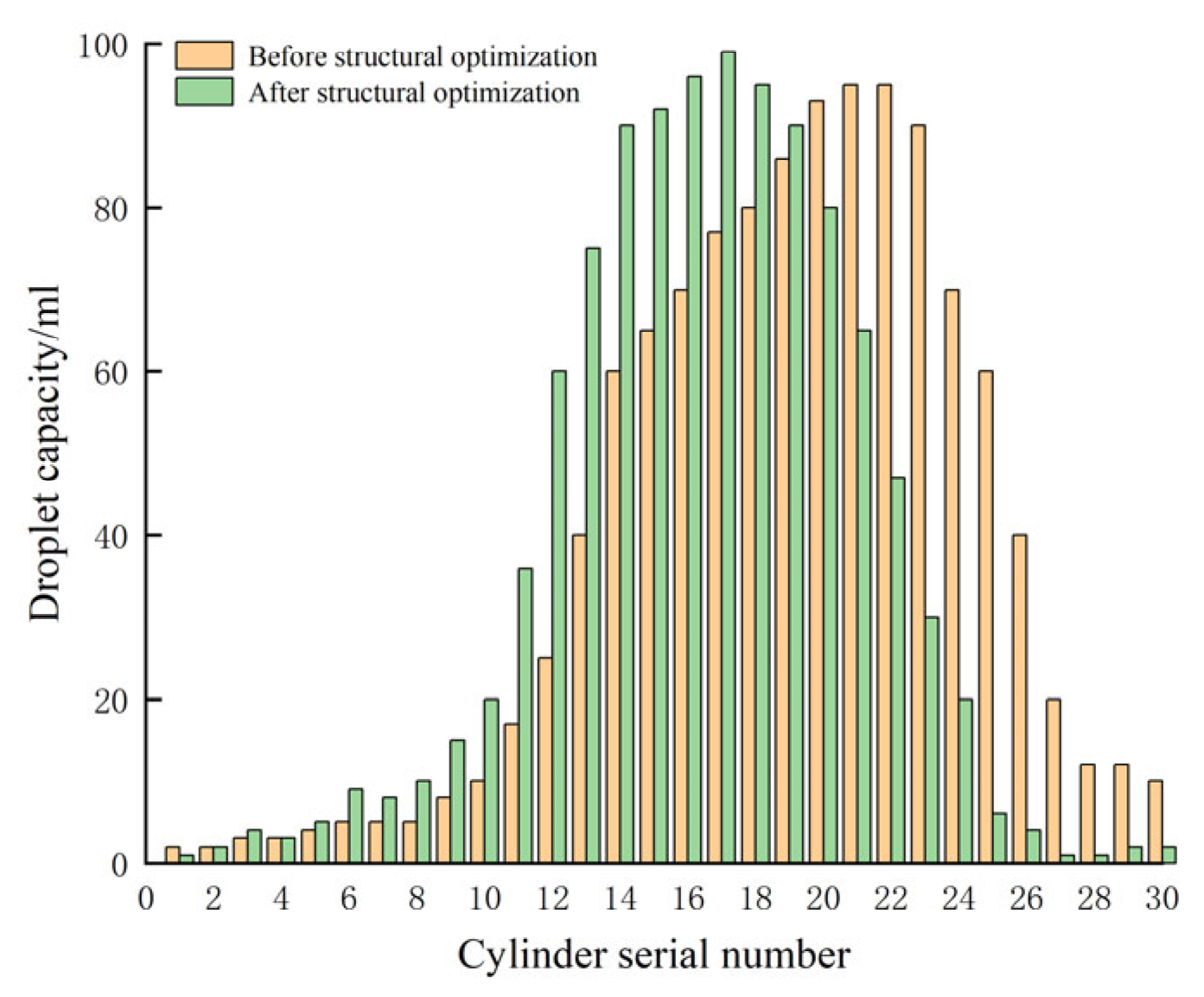
| Parameters | Numerical |
|---|---|
| Air duct diameter (mm) | 520 |
| Length of air duct (mm) | 180 |
| Number of fan blades (unit) | 6 |
| Installation angle of fan blades (°) | 10 |
| Diameter of air baffle (mm) | 700 |
| Air outlet width (mm) | 122 |
Disclaimer/Publisher’s Note: The statements, opinions and data contained in all publications are solely those of the individual author(s) and contributor(s) and not of MDPI and/or the editor(s). MDPI and/or the editor(s) disclaim responsibility for any injury to people or property resulting from any ideas, methods, instructions or products referred to in the content. |
© 2023 by the authors. Licensee MDPI, Basel, Switzerland. This article is an open access article distributed under the terms and conditions of the Creative Commons Attribution (CC BY) license (https://creativecommons.org/licenses/by/4.0/).
Share and Cite
Jing, S.; Ren, L.; Zhang, Y.; Han, X.; Gao, A.; Liu, B.; Song, Y. A Simulation and Experiment on the Optimization Design of an Air Outlet Structure for an Air-Assisted Sprayer. Agriculture 2023, 13, 2277. https://doi.org/10.3390/agriculture13122277
Jing S, Ren L, Zhang Y, Han X, Gao A, Liu B, Song Y. A Simulation and Experiment on the Optimization Design of an Air Outlet Structure for an Air-Assisted Sprayer. Agriculture. 2023; 13(12):2277. https://doi.org/10.3390/agriculture13122277
Chicago/Turabian StyleJing, Shuaijie, Longlong Ren, Yue Zhang, Xiang Han, Ang Gao, Baoyou Liu, and Yuepeng Song. 2023. "A Simulation and Experiment on the Optimization Design of an Air Outlet Structure for an Air-Assisted Sprayer" Agriculture 13, no. 12: 2277. https://doi.org/10.3390/agriculture13122277
APA StyleJing, S., Ren, L., Zhang, Y., Han, X., Gao, A., Liu, B., & Song, Y. (2023). A Simulation and Experiment on the Optimization Design of an Air Outlet Structure for an Air-Assisted Sprayer. Agriculture, 13(12), 2277. https://doi.org/10.3390/agriculture13122277









